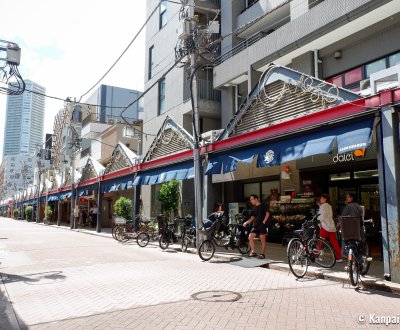Tsukishima Monja Street
Tokyo’s Okonomiyaki Street
Tsukishima Monja Street is a street lined up with monjayaki restaurants, located on Tsukishima artificial island, in Tokyo’s Chuo ward. Monjayaki is one of the capital’s food specialties, a softer texture version of the okonomiyaki garnished savory pancake, cooked on a flat iron griddle.
The monjayaki (もんじゃ焼き) or monja is a specialty dish of the Kanto area and Tokyo, and a derivative of the okonomiyaki (お好み焼き) a savory garnished crepe commonly found in Osaka and Hiroshima.
This typical dish of the capital is associated to Tsukishima Island, known as its birthplace. Tsukishima’s land, at the mouth of the Sumida River in Tokyo Bay, was reclaimed at the end of the 19th century. It is easily accessible by subway 🚇 and only a 15 minutes’ walk from Tsukiji Outer Market. Tsukishima Monja Street is characterized by arcades covered by steep roofs, under which dozens of restaurants specializing in the monja and okonomiyaki cooking are lined up. They are part of a neighborhood association and have their own local mascot: a ninja cat 🐈 named Tsukishima Ninja Monnyan.
While rather dull and quiet at lunchtime, the street enlivens at nightfall with the nearby offices’ employees flocking there at the end of their working day to share a hot pan dish and a cold drink, like a Japanese beer 🍺. Nicknamed "Monja Town", the area gives a shitamachi vibe, an atmosphere reminding of the merchant plebeian lower town of the Edo period (1603 - 1868).
Monja restaurants have tables set with a flat iron griddle (teppanyaki) at their center so customers can cook their own garnished pancake. A staff member can also cook and put on a show of skills and fastness as they prepare the monjayaki batter.

How to cook the monja on the hot griddle?
First select the ingredients you would like to eat. The choice usually includes:
- Shredded cabbage;
- Small sea food like shrimps, fry, or tiny bits of squid, cuttlefish and octopus;
- Pork meat;
- Ginger;
- Various vegetables: leeks, onions, etc.; and,
- Grated cheese for a more modern and creamy dish.
These ingredients are placed in a bowl that also contains a broth made with flour, water and dashi.
Sauté the filling
Sprinkle the hot griddle with a spoonful of oil. When the oils reaches the good temperature, just pour the raw ingredients on the griddle, but keep the broth in the bowl. Sauté the ingredients until slightly brown, and until cabbage softens and seafood and meat are thoroughly cooked.
Add the broth at the center of the circle
When the filling is cooked, shape it into a circle with a hole in the middle, just like a donuts. Pour the broth at the center of the circle, in small quantities each time so the liquid does not overflow the filling circle. Let it cook until water evaporates and it acquires a thicker texture.
Mix the batter
When the broth is thick enough and its texture is similar to a pancake batter, use the spatula to mix it with the filling ingredients. Then, spread the mixture evenly on the hot plate and let it cook a few more minutes, letting small bubbles forming at its surface. You can then add nori seaweed powder and spices (optional).
Enjoy the monjayaki
Using the small individual spatula, cut a small bit into the galette while it is still retaining some moisture. You can let it cook a little longer before enjoying it, but be careful as it is very hot! After eating the dish, you can scrape the plate for the remaining broth that cooked into a nice crust.

A monjayaki costs on average between ¥900 (~US$6.12) to ¥1,200¥ (~US$8.17) per person, drinks not included. In the same area, several shops and cafés offer sweet food, such as melonpan brioche, that can be enjoyed as a dessert.
On a side note and slightly away from Monjayaki street, in 2023 Kyodo Senpaku (a Japanese whale hunting company) opened a shop in Tsukishima with several vending machines dispensing frozen whale meat, a self-service that arose controversy even in Japan.


